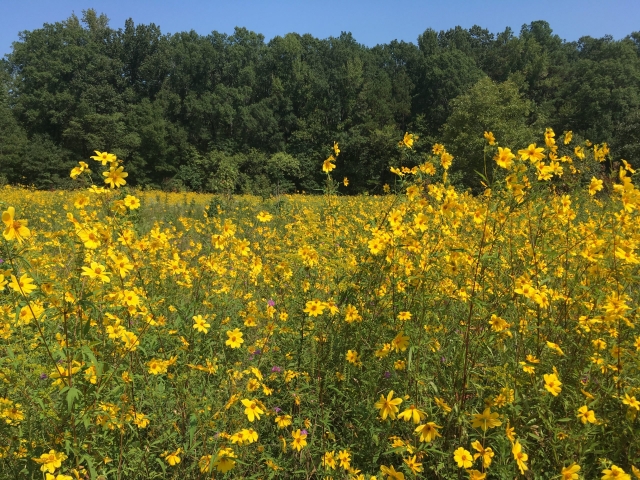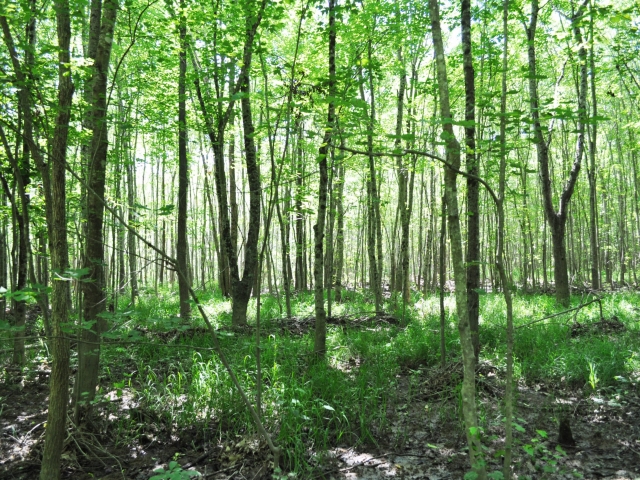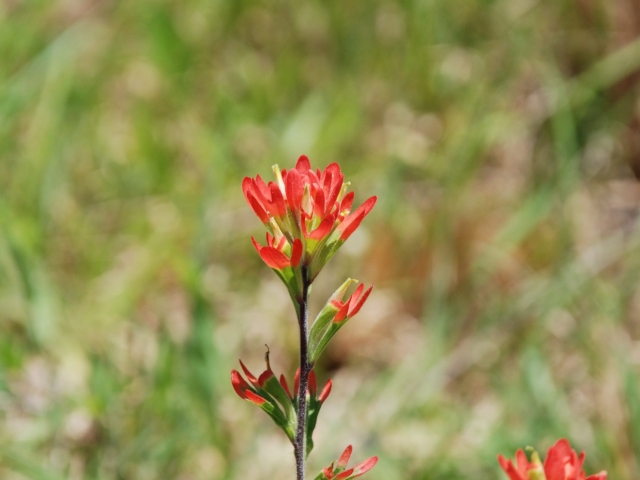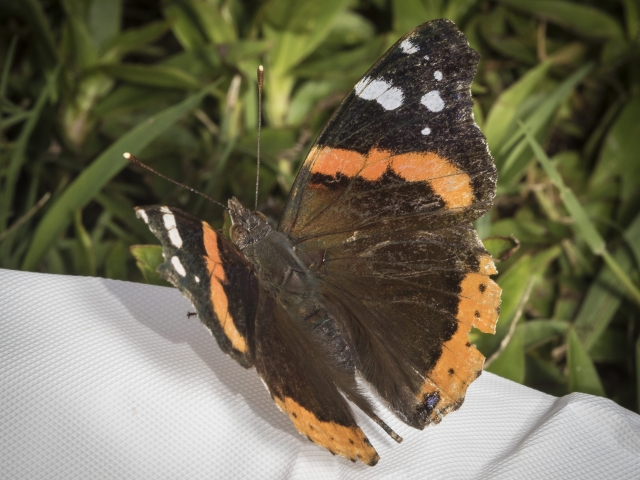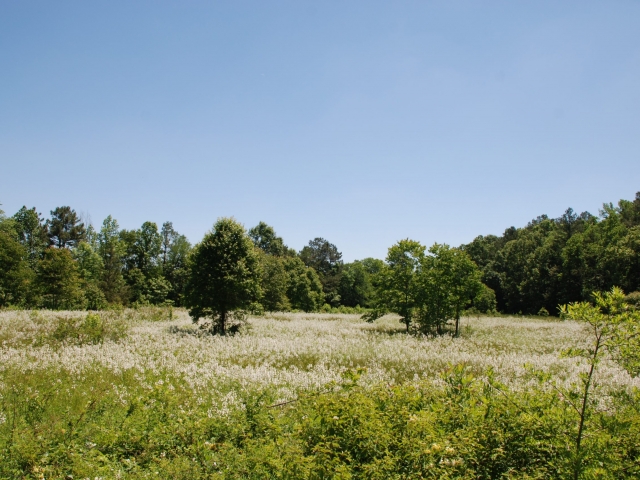Plan Your Visit
Mason Farm Biological Reserve is a place for research, education, and appreciation of the natural world. This 367-acre wildlife preserve and natural area in Chapel Hill is home to over 800 species of plants, 216 species of birds, 29 species of mammals, 28 species of fish, 28 species of reptiles, 23 species of amphibians, and 67 species of butterflies. Part of the roughly 40,000 acres of protected lands surrounding Jordan Lake and its tributaries, Mason Farm serves as a wildlife corridor between Chapel Hill and the Cape Fear River Basin to the Atlantic Coast.
The 1.8-mile Old Farm Trail passes through open bottomland meadows, old-growth swamp forests, oak hickory forests, and beaver wetlands. It connects to the 127-acre Parker Preserve via the Mason Farm Trail.
Access
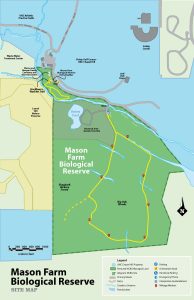
Mason Farm Biological Reserve is open dawn to dusk, 365 days a year. As this is a site for wildlife conservation and research, you must fill out a permit form before visiting. Fill out your permit.
Directions & Parking
There are two ways to reach Mason Farm Biological Reserve.
1. Old Mason Farm Road and Finley Golf Club. Click for Google Maps directions.
This route passes through the Finley Golf Club parking lot and continues on a 0.3-mile gravel road. When you reach Morgan Creek, you cross the stream on a low-water bridge. When the gage reads less than 4.5 feet, it is usually safe to cross. Check the gage height here. Once you cross the creek, you can park in the Mason Farm visitor parking lot.
2. Mount Carmel Church Road and Parker Preserve. Click for Google Maps directions.
Parker Preserve, off of Mount Carmel Church Road in Chapel Hill, offers an alternative entrance to Mason Farm Biological Reserve. You can park in the designated roadside lot on Parker Road and then hike down around 1.25 miles to Mason Farm.
Trails
The 1.8-mile Old Farm Trail is a relatively flat loop that takes visitors through many of the habitats on the property. You will see a mix of forests and meadows, as well as old drainage ditches that were dug to help drain the bottomlands when the property was used for agriculture. The trail surface is primarily an old gravel road, though in some places it’s covered with grass.
What will I see?
In the ancient woodlands and restored prairies of Mason Farm, you’ll see rare animals and plants. You might also see researchers and conservation staff out working to keep the land free of invasive species and restore native plants.
Visit Safely
Help us maintain Mason Farm as a sanctuary for plants and wildlife. This means:
- No pets
- No bikes or motorized vehicles beyond the parking lot
- No traps, firearms, or weapons of any kind are permitted.
- No hunting, trapping, fishing, camping, or fires.
- Do not harm, kill, or remove plants or wildlife (this includes snakes and turtles).
- Leave nature as you found it: stay on designated paths, and carry out any materials you bring in.
- Call 911 for emergencies
Support the Reserve
Apply for a Visitor Permit
History
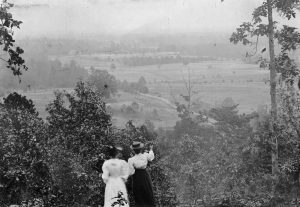
The land where Mason Farm Biological Reserve sits is rich with biological and human history. Archaeological evidence from the site and nearby lands shows that Indigenous people lived in this area for over 10,000 years, first as mobile bands of hunter-gatherers and later establishing permanent villages and farming the rich alluvial soils of the floodplain. In the 1740s, the first European colonizers arrived in the area and found the recently abandoned farm fields of the indigenous peoples, whose populations had been driven away or ravaged by European diseases such as smallpox. Mark Morgan received a 10,000-acre grant from the Duke of Granville and began the process of clearing the fallowed fields for agriculture. Drainage ditches and levees were constructed (largely using the labor of enslaved people) to make the rich bottomlands easier to farm, but some forested areas were never clear-cut, and these “old growth” stands survive today. The Morgan family established their home where the Finley Golf Course clubhouse presently sits, on a knoll upslope a short distance from the creek that bears their name. This location kept them out of the way of the floodwaters that would inundate the bottomlands when Morgan Creek spills over its’ banks.
Over time the family sold off most of the land that Mark Morgan received in the original grant, and in 1894 when Mark Morgan’s great-granddaughter Mary Elizabeth (Morgan) Mason found herself widowed and with no surviving heirs, she bequeathed the remaining 800+ acres to the University of North Carolina upon her death. For the next 90 years the fields remained in cultivation, being leased to local farmers and later to the US Soil Conservation Service. In 1984 UNC designated the site as the Mason Farm Biological Reserve, with management responsibilities for the property given to the North Carolina Botanical Garden. The Garden has been actively conducting ecological restoration of the old farm field to native plant meadows ever since, reintroducing scores of species, treating and removing invasive species, and using natural disturbance processes like prescribed fire to maintain a diversity of habitat types.
John Terres
“It is in these small, wild places, refuges kept wild by their isolation and the protection of the animals in them, that the naturalist finds the Last Frontier. And in this much-civilized land he is that unusual paradox: both a cultured and a primitive man. With love for the wildlife that he studies, and with songs and poems in his heart, he has returned, hundreds or even thousands of years, to his hunter-trapper ancestors to learn the language of the sign —the trail in the dust, the lone feather, the traces of wild fur on the tree — that tells him what animal has passed there, what it fed upon, and where it has gone. But when he crushes the grass under his feet, it springs up again, and there is no blood under the tracks.”
Also see A Guide to the Old Farm Trail – A Garden publication telling the history of the fields and forests of Mason Farm Biological Reserve.
Check The Gage Before You Go
Please note: Visiting Mason Farm Biological Reserve requires fording a low water crossing in your vehicle. The low water crossing may be inaccessible following heavy rain events or periodic water release from upstream. If the Gage height is less than 4.5 feet, it is generally safe to cross in your vehicle.

